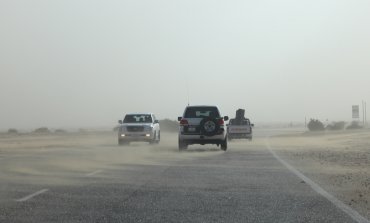
DUBAI, United Arab Emirates – The Middle East is transitioning to higher quality lubricants but at a slower pace than previously thought as recent research found monogrades and high-viscosity motor oils continuing to dominate heavy- and light-duty markets.
Kline & Co. consultants reported recently that monogrades still account for 50 to 55 percent of the regions heavy-duty diesel engine oil market, which consumes between 600,000 and 700,000 metric tons per year, with SAE 50, 40 and 30 grades highly prevalent. That is in stark contrast to the global average of just 3 percent according to data from additive supplier Infineum.

Photo: Philip Lange/Shutterstock
Cars traverse a desert highway during a sandstorm in Dohar, Qatar. The Middle East is transitioning to higher quality lubricants but at a slower pace than previously thought.
Beyond headline grabbing statistics, though, there are structural and environmental reasons for the differences. Some of the regions large heavy-duty markets, such as Egypt, have old fleets that are key factors in the ongoing use of monogrades, and there are few signs of that changing in the short term. Indeed, the age of that vehicle parc is the reason SAE 50 and 40 monograde oils total more than 70 percent of the Egyptian market, Kline Project Manager Sushmita Dutta said at the Base Oil and Lubes Middle East Conference in Abu Dhabi on April 25.
The regions harsh, dusty conditions also help prolong the use of monogrades; silica ingress and high ambient temperatures habituate short oil drain intervals, reducing some of the benefits of using more expensive, higher quality oils.
In Saudi Arabia, an erstwhile monograde market, regulations are forcing change that will resonate throughout the Gulf, said Rajeev Sivaraman, technical services manager at Jeddah-based Petromin Corp. He points to the Gulf Standard Organizations introduction of API CH-4 as the minimum benchmark for heavy-duty oils.
This has come in to force this year, which resulted in [the] withdrawal of monogrades from the GCC market – so monogrades, which used to constitute around 51 percent of the HDDO [market] have disappeared and been replaced with multigrade oils, the most popular being 15W-40.
GSO is a pan-Gulf body charged with unifying standards, although critics say it lacks powers of enforcement. The conversion to multigrades is also sped by the opening in recent years of several base stock plants in the region that produce API Group II and III base stocks. Until then, the region produced Group I oils almost entirely.
Disparity with global trends is even more vivid in the passenger car sector, where heavy oils remain prevalent. Kline estimates 20W engine oils account for an astounding 65 to 70 percent of the Middle Eastern market, which Kline estimates at approximately 400,000 to 500,000 t/y. That compares with a global figure of just 1 percent according to Infineum.
Yet even in a relatively sophisticated automobile market like the U.A.E., 20W engine oils represent more than 60 percent of the market. Developed markets adopted 10W grade oils decades ago, moved onto 5W oils and are now rapidly embracing 0W. As in the heavy-duty market, high ambient temperatures and reluctance by consumers to accept the qualitative argument in favor of higher specification oils, has sustained heavy oil consumption in the Gulf.
Sanjay Singh, GP Globals head, lubricants and greases for the Middle East and North Africa, said cost historically has also been a important determinant of the slow conversion to lighter oils. OEM service was quite expensive. Most vehicles, when out of warranty, chose to go to independent garages or fuel stations for oil and filter change. These garages, keeping in mind the drain period being recommended by OEM service centers, also looked at 20W-50 only. In some cases independent garages have recommended drain periods as low as 2,000 kilometers, Singh added.
Klines overall findings highlight the fact that the region continues to lag behind other emerging markets and is substantially behind developed markets such as the United States, the European Union and Japan, where monogrades and heavy motor oils account for small proportions of the market. Nevertheless, the Middle East is gradually tilting towards better quality lubricants, driven by OEM recommendations that prescribe lighter oils for new vehicles. Most OEMs are now recommending a 10,000 km drain period and are the main drivers for 10Ws and 5Ws starting to pick up volumes, Singh said.
If the region is starting to shift to better quality oils, that trend could be slowed by geopolitics. Expectations that Iran would reemerge as an important auto manufacturing hub are likely to be dashed with the imminent snap-back of U.S. sanctions on the automobile sector next month and oil sector in November. Since the easing of the last round of sanctions, Iran has been able to import higher quality base stocks and that has been reflected in a rise in the use of multigrade lubricants, although monogrades still account for around half of the market. Domestic Group I base stocks are expected once again to be the main supply source for the Iranian lubricants market amid renewed political tensions.